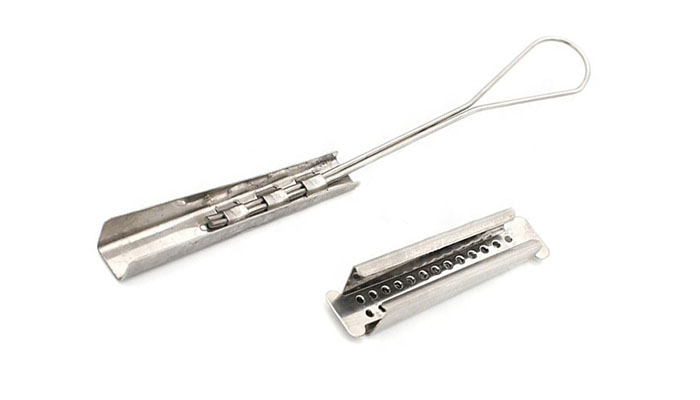
A drop wire clamp is a device used o the power transmission line to secure and support drop wires or service wires. Drop wire clamps are also known as service drop clamps. They are mainly used on the telecommunications and cable installation projects. It attaches the drop wire to supporting structure like pole or building. They also provide strain relief to prevent damage to the wire. The drop wire clamp is resistant to corrosion and weathering. This is to ensure long-lasting performance in outdoor environments. They also maintain proper positioning and support of the drop wires. Drop wire clamps also help prevent sagging, tension-related issues and damage to the drop wire. This ensures that there is reliable signal transmission and uninterrupted service.
Components of the clamp
The drop wire clamp consists of a number of components that ensure ease of work to secure and support drop wire. The features depend on the design, manufacturer and the intended purpose of the clamp. Below are the common components of the drop wire clamp.
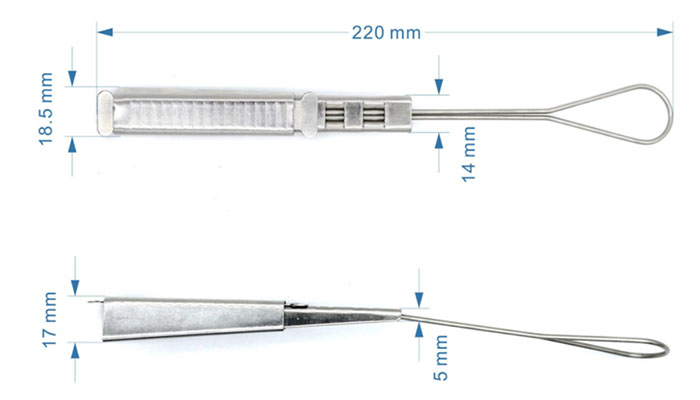
- Clamp body – this is the main component of the drop wire clamp that is from durable materials like metal or plastic. It has grooves designed to hold the drop wire securely in place.
- Bail or retainer – the bail provides extra support and helps holds the drop wire in position. It may be a separate component that attaches to the clamp body.
- Mounting hardware – mounting hardware helps to secure and attach the drop wire clamp to the supporting structure. They include bolts, screws and bolts.
- Strain relief device – a strain relief device incorporates into the drop wire clamp to provide extra support and relief tension on the drop wire. They help prevent damage to the wire caused by excessive stress or movement.
- Insulation or protective coating – drop wire clamps have insulation on the coating on the contact surfaces to prevent damage to the drop wire’s insulation. This ensures a secure and reliable connection on the installation.
- Grounding lug – this applies in certain cases which enables proper grounding of the drop wire. This helps to protect against electrical surges and static discharge.
Types of drop wire clamps
The type of clamp chosen for installation depends on factors like the application, conductor material, voltage level and installation requirements. They should also adhere to the industry standards, specifications and local regulations for a particular power transmission project. The following ae the major types of drop wire clamps.
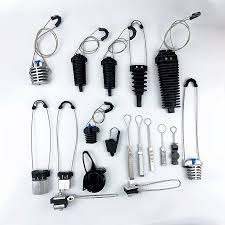
- Wedge type drop wire clamp – this clamp consists of a wedge which inserts into the body as the clamp tightens. It provides a secure grip on the wire and is commonly used for both copper and aluminum drop wires.
- Parallel groove clamps – these clamps work in both overhead power lines and service drops. They consist of a body with parallel grooves where the conductor settles. The clamps are then tightened to grip the conductor securely. Parallel groove clamps are also used together with dead end fittings to terminate or anchor the drop wire.
- Clevis type drop wire clamps – clevis clamps feature a U-shaped clevis or yoke that holds the drop wire. The clevis secures with a pin or bolt which provides a simple and effective method of attachment. These clamps are mostly used for medium-voltage service drops. They are from galvanized steel or corrosion resistance materials.
- Suspension type drop wire clamps – these help to suspend the drop wire from messenger wires or support structures. They feature a saddle-shaped body that holds the drop wire and a bolt or fastening mechanisms to secure it. Suspension type clamps offer mechanical strength and prevent damage to the drop wire.
Applications of the clamps
Drop wire clamps work in different applications in the fields like power transmission and distribution lines. The applications vary depending on the requirements of the power transmission systems, local regulations and industry standards. The following are the drop wire clamp application areas.
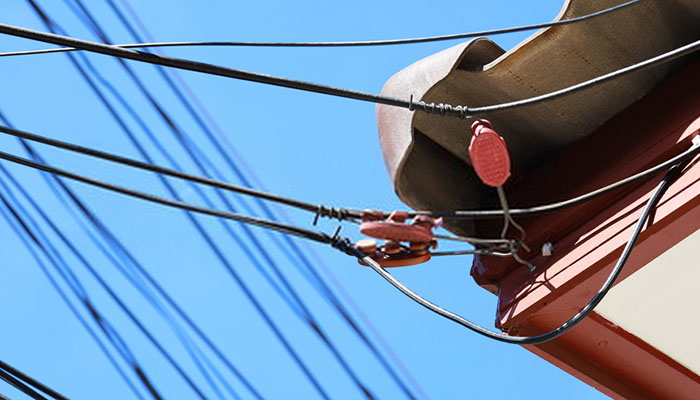
- Messenger wire suspension – drop wire clamps help maintain the proper elevation and alignment of the messenger wire. This ensures the stability and integrity of the power transmission systems.
- Service drop connections – drop wire clamps secure and support drop wires that connect service cables to buildings or other structures. They provide a reliable attachment point and help maintain the proper tension of the drop wire.
- Temporary installations – temporary installations for drop wire clamps include construction and maintenance activities. Temporary installations offers a quick and secure method of attaching temporary drop wires or cables to structures until permanent connections establish.
- Overhead power lines – drop wire clamps work with dead end fittings to terminate or anchor overhead power lines. They help secure the conductors and prevent sagging or movement caused by wind, ice or other environmental factors.
- Fiber optic cable support – drop wire clamps also support fiber optic cables in communications and data transmission applications. They provide a secure attachment point for the cables. This prevents sagging and maintaining proper signal transmission.
Installation of drop wire clamps
Installation process may vary based on factors such as the specific type of drop wire clamp, local regulations and industry practices. Always refer to the manufacturers’ guidelines and consult with professionals for guidance. This ensures proper and safe installation procedures. Here is a step-by-step guide on drop wire clamp installation.
- It is vital to adhere to safety guidelines and wear appropriate personal protective equipment. You should also ensure that the area is clear of any hazards and take proper precautions to prevent accidents.
- Choose the appropriate type and size of drop wire clamps based on the application, conductor material, voltage level and installation requirements.
- Make sure the installation site is clean and free from any debris or obstructions. These may limit the installation and performance of the device.
- Place the drop wire clamp at the desired location along the power transmission line or service drop. It should be properly aligned and positioned according to the installation requirements.
- Using the appropriate hardware, secure the drop wire clamp to the support structure or pole.
- Insert the drop wire into the clamp and ensure it is properly seated.
- Adjust the tension of the drop wire to the required specifications which is to ensure that it is properly aligned and does not sag excessively.
- Perform a thorough inspection to ensure that everything is secure, properly aligned and meets the required standards and specifications.
Choosing the best drop wire clamp
Choosing the best drop wire clamp needs consideration of several factors. This is to ensure it meets the intended application requirements. Addirionally, consult with industry professionals to achieve valuable insights and guidance. The following are the factors to consider.
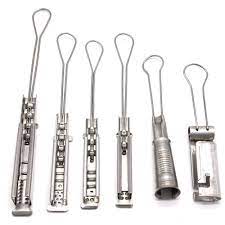
- Determine the intended application of the drop wire clamp. Consider the need for services drop connections, overhead power lines fiber optic cables or other purposes. Different applications may require specific clamp designs and features.
- Take into account the material and size of the conductor that the clamp will be securing. Consider whether the clamp is suitable for the specific conductor material. Some of these materials include copper or aluminum, and the size range it can accommodate.
- Higher voltage lines may require clamps with additional insulation or specific voltage ratings. This is to ensure proper electrical performance and safety.
- Evaluate the mechanical strength of the clamp. It should be able to withstand the tension and loads placed on the drop wire without deformation or failure. Look for clamps made of durable and corrosion-resistant materials that withstand environmental conditions.
- Installation requirements and constraints of the power of the power transmission lines. these include available space, mounting options and compatibility with existing hardware.
- Check whether the drop wire clamp complies with relevant industry standards and specifications.
- Consider the reputation and track record of the manufacturer or supplier. They should have a track record of producing high-quality and reliable products.
- Evaluate the cost effectiveness of the drop wire clamp before purchase. You should also consider the overall value, durability and performance of the clamp.
Frequently asked questions
What is a drop wire clamp as used on the overhead transmission line?
A drop wire clamp helps to secure and support the drop wires connecting service cables to buildings.
What are the advantages of using drop wire clamps on power transmission lines?
Drop wire clamps offer several benefits such as secure attachment point, proper tension, ease of installation, various types and sizes and corrosion resistance.
What are the disadvantages of using drop wire clamps on the power transmission lines?
Drop wire clamps have various limitations to consider before selecting for your application. These include llimited adjustability, compatibility issues, retrofitting challenges, frequent maintenance and higher costs.
